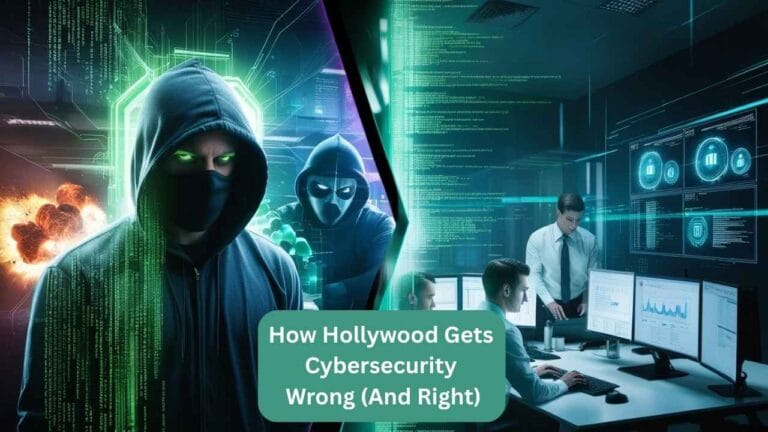Hollywood loves to make hacking look like a high-speed, neon-lit video game, but real cybersecurity is far less glamorous (and much more important). From Mission: Impossible’s instant facial recognition to Mr. Robot’s ultra-realistic hacks, filmmakers often prioritize drama over accuracy. But when these myths shape public perception, they put real people at risk.
As a cybersecurity consultant who’s cleaned up after Hollywood-inspired breaches (like a client who thought “password123” was safe because “that’s what the hero used in Die Hard 4“), I’ll separate fact from fiction. You’ll learn:
Which movies get cybersecurity (mostly) right
The most dangerous myths Hollywood perpetuates
How to protect yourself from real-world threats
Let’s dive in, no technobabble, just actionable insights.
“Hacking Is a Solo Genius in a Hoodie”: Here’s What’s Really Happening
Hollywood myth: A lone hacker types furiously on a glowing keyboard and infiltrates the Pentagon in 30 seconds.
Reality: Modern cyberattacks are organized operations with:
- Phishing teams crafting fake emails
- Malware developers writing code
- Money mules laundering funds
A 2024 IBM report found that 83% of breaches involve multiple attackers.
Real-world example:
One client (let’s call her Sarah) thought her small business was safe because “no hacker would target us.” Then her bookkeeper clicked a fake invoice email, leading to a $200K ransomware attack traced to a Russian cybercrime syndicate.
Key Takeaway:
“Cybercriminals operate like corporations. Your ‘small’ data is valuable in bulk.”
The Hidden Factor Hollywood Ignores: Time
Counterintuitive insight: Real hacking is boringly slow.
While movies show instant breaches, most attacks take weeks or months of:
- Reconnaissance (studying your social media for password hints)
- Testing vulnerabilities (like guessing weak passwords)
A 2025 Google study revealed:
60% of accounts are hacked via reused passwords from old breaches
The average attacker spends 3 weeks inside a network before being detected
Actionable Tip:
“Use a password manager (like Bitwarden or 1Password) and enable 2FA. This blocks 99% of ‘slow burn’ attacks.”
“Encryption Is Unbreakable!”: Why This Myth Backfires
Hollywood trope: “We’re locked out! The data is AES-256 encrypted!”* (Cue dramatic music.)
Truth: Encryption can be broken via:
- Social engineering (tricking users into handing over keys)
- Quantum computing (coming sooner than you think)
Case Study:
A tech CEO client insisted his “military-grade encryption” made him invincible, until a hacker called his IT guy pretending to be him and got the master password.
Visual Cue:
“Imagine a bank vault with an armored door… and a receptionist who gives keys to anyone claiming to be the manager. That’s how most encryption fails.”
Step-by-Step: Protect Yourself Like the Pros (No Hollywood BS)
Follow this sequence to secure your accounts in <1 hour:
Phase 1: Prep (15 mins)
- Update all devices: 80% of attacks exploit known, patchable flaws (CISA, 2024)
Phase 2: Modify (20 mins)
- If you reuse passwords: Switch to a manager (Bitwarden is free)
- If you skip 2FA: Enable it now (SMS is okay, but Authy/Google Authenticator is better)
Phase 3: Progress (25 mins)
- Add a hardware key (Yubikey) for high-value accounts (email, banking)
- Freeze your credit (blocks identity theft)
Pro Tip:
“Hollywood won’t show this because ‘guy quietly updating software’ isn’t cinematic… but it stops most real-world attacks.”
Movies That Surprisingly Get It Right
- Mr. Robot (2015–2019):
- Accurate: Social engineering, password reuse risks
- Dramatized: The speed of hacks
- The Social Network (2010):
- Accurate: Dorm-room coding culture
- Dramatized: Zuckerberg didn’t actually “hack” Harvard’s network
Final Thought: Be the Hero of Your Own Story
Cybersecurity isn’t about outsmarting hackers—it’s about making their job too annoying to bother.
Do this today: Check 2FA settings on your email
Stop this now: Using movie passwords (“Rosebud”, “Godzilla”, etc.)
“In Hollywood, hackers always lose in Act 3. In real life, you win by never being an easy target.”





